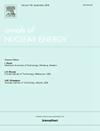具有连续能量精度的动态多群截面生成方法
IF 2.3
3区 工程技术
Q1 NUCLEAR SCIENCE & TECHNOLOGY
引用次数: 0
摘要
为了在堆芯计算中考虑谱变化和周围环境的影响,提出了一种基于粗网格传输码COMET的实时多群截面生成方法。该方法由(1)连续能量随机响应反应速率生成模块和(2)确定性多群截面更新模块组成。第一个模块通过扩展COMET的连续能量响应函数生成器来解决一组具有入射通量边界条件(或表面源)的局部固定源输运问题,并生成各种响应反应率的库。第二个模块构建感兴趣区域的相空间(在空间、角度和能量上连续)通量分布,作为预先计算库中的元素的叠加,然后实时生成多群截面。采用连续能量蒙特卡罗方法,对一组程式化的超高温堆(VHTR)单燃料块和全堆芯的多群截面直接进行了基准测试。基准测试结果表明,新方法在具有动态计算速度的同时,可以达到接近连续能量蒙特卡罗方法的精度(即在随机不确定性的两个标准差内)。本文章由计算机程序翻译,如有差异,请以英文原文为准。
On-The-Fly multigroup cross section generation method with continuous energy accuracy
In this paper, an on-the-fly multigroup cross section generation method is developed and implemented into the coarse mesh transport code COMET to account for the effects of spectral change and surrounding environment in reactor core calculations. The method consists of (1) a continuous energy stochastic response reaction rate generation module and (2) a deterministic multigroup cross section updating module. The first module is developed by extending the continuous energy response function generator for COMET to solve a set of local fixed-source transport problems with incident flux boundary conditions (or surface sources) and to generate a library of various response reaction rates. The second module constructs the phase space (continuous in space, angle, and energy) flux distribution in the regions of interest as a superposition of elements from the pre-computed library and then generates the multigroup cross sections on-the-fly. The method is benchmarked against the multigroup cross sections directly by continuous energy Monte Carlo in a set of stylized Very High Temperature Reactor (VHTR) single fuel block and whole core benchmark problems. Benchmark results demonstrate that the new method can achieve accuracy close (i.e., within two standard deviation of stochastic uncertainty) to that of continuous energy Monte Carlo while having on-the-fly computational speed.
求助全文
通过发布文献求助,成功后即可免费获取论文全文。
去求助
来源期刊

Annals of Nuclear Energy
工程技术-核科学技术
CiteScore
4.30
自引率
21.10%
发文量
632
审稿时长
7.3 months
期刊介绍:
Annals of Nuclear Energy provides an international medium for the communication of original research, ideas and developments in all areas of the field of nuclear energy science and technology. Its scope embraces nuclear fuel reserves, fuel cycles and cost, materials, processing, system and component technology (fission only), design and optimization, direct conversion of nuclear energy sources, environmental control, reactor physics, heat transfer and fluid dynamics, structural analysis, fuel management, future developments, nuclear fuel and safety, nuclear aerosol, neutron physics, computer technology (both software and hardware), risk assessment, radioactive waste disposal and reactor thermal hydraulics. Papers submitted to Annals need to demonstrate a clear link to nuclear power generation/nuclear engineering. Papers which deal with pure nuclear physics, pure health physics, imaging, or attenuation and shielding properties of concretes and various geological materials are not within the scope of the journal. Also, papers that deal with policy or economics are not within the scope of the journal.
 求助内容:
求助内容: 应助结果提醒方式:
应助结果提醒方式:


